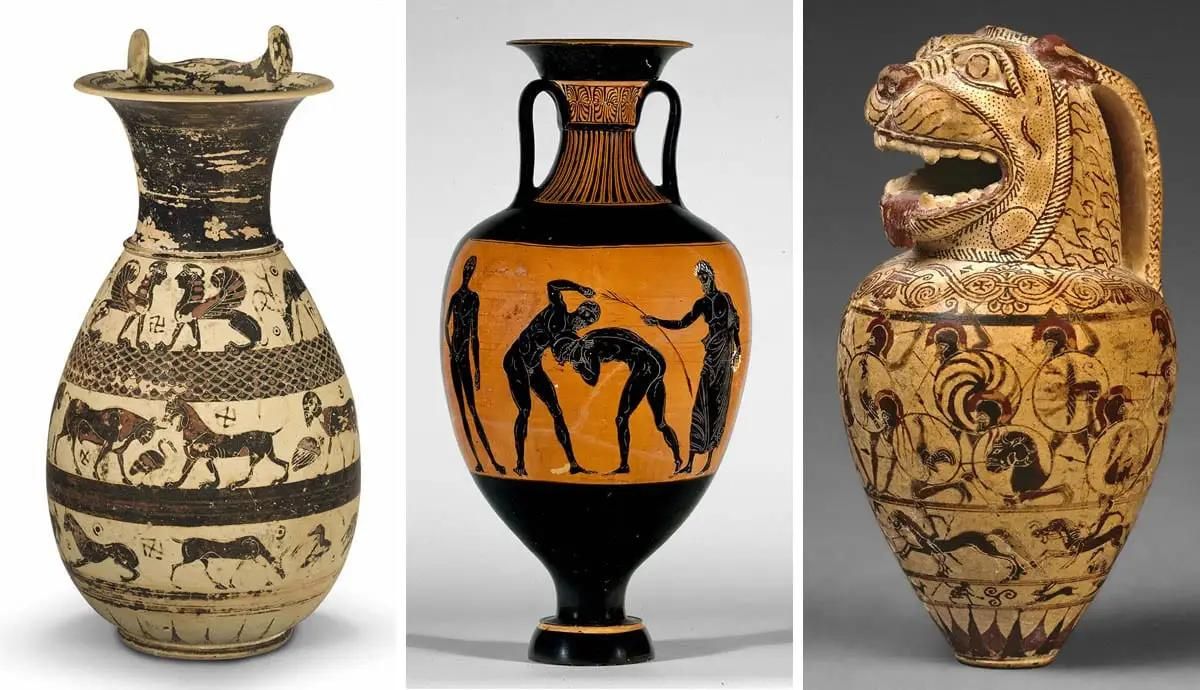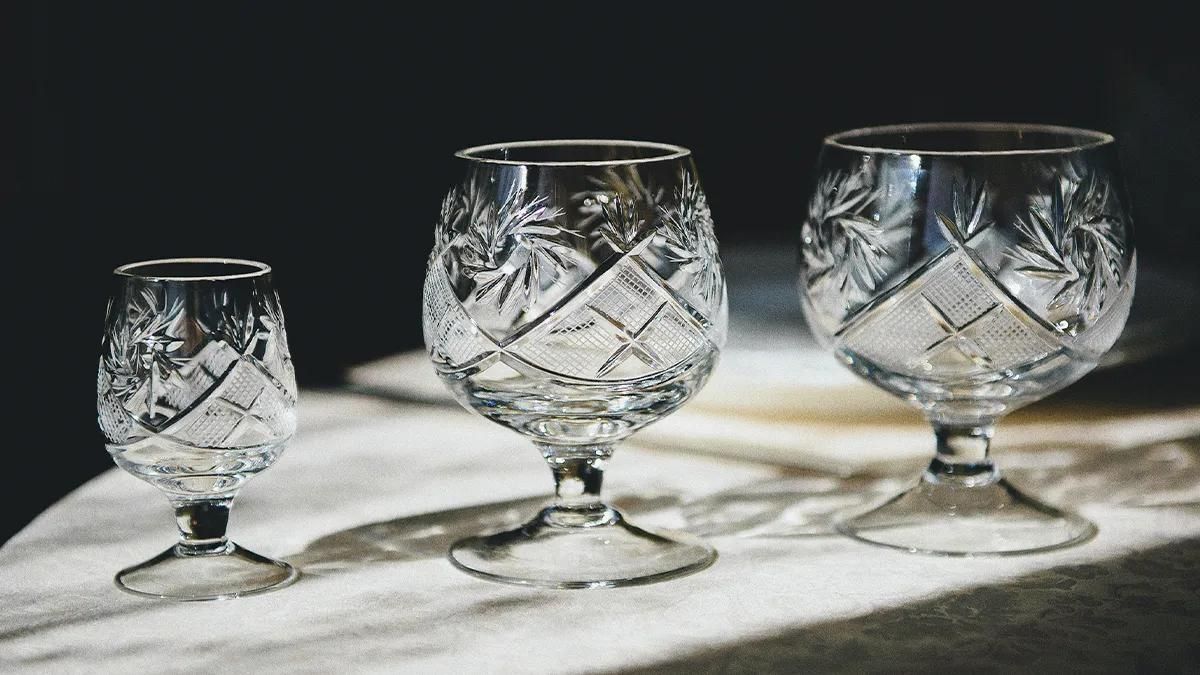

Articles
What Were Greek Vases Used For
Modified: October 20, 2024
Discover the significance of Greek vases throughout history. Explore our informative articles to learn about their uses in ancient Greece and the artistic techniques employed in their creation.
(Many of the links in this article redirect to a specific reviewed product. Your purchase of these products through affiliate links helps to generate commission for Storables.com, at no extra cost. Learn more)
Introduction
Greek vases are not merely decorative artifacts; they are windows into the ancient Greek civilization, providing insights into their culture, beliefs, and daily life. These unique vessels, created by skilled artisans, have withstood the test of time and continue to capture the imagination of art enthusiasts and historians alike.
The art of pottery in ancient Greece dates back thousands of years, with its origins tracing back to the Bronze Age. Greek vases are known for their exquisite craftsmanship, intricate designs, and use of vibrant colors, making them a significant part of ancient Greek art and archaeology.
This article delves into the fascinating world of Greek vases, exploring their historical significance, the various types and functions, the depictions and themes conveyed through their intricate designs, the materials and techniques used in their production, and the importance of their preservation in modern times.
Join us on a journey back in time to uncover the secrets and stories held within these ancient vessels, shedding light on the lives of the people who once used them and providing valuable insights into the rich cultural heritage of ancient Greece.
Key Takeaways:
- Greek vases are more than just decorative objects; they are windows into ancient Greek civilization, offering insights into daily life, cultural beliefs, and historical events through their intricate designs and narratives.
- The preservation of Greek vases is crucial for understanding ancient Greece, as these vessels provide valuable archaeological evidence, contribute to scholarly research, and serve as educational resources, promoting cultural exchange and appreciation for the artistic achievements of the past.
Read more: Historical Uses Of Greek Urns
Historical Background
The art of pottery in ancient Greece has a long and storied history, dating back to as early as the Neolithic period around 6000 BCE. It evolved alongside other aspects of Greek civilization, playing a crucial role in various aspects of daily life.
During the Bronze Age, pottery making in Greece was heavily influenced by cultures such as the Minoans and Mycenaeans. The Minoans, an advanced civilization on the island of Crete, introduced techniques like wheel-throwing and decorative motifs. The Mycenaeans, on the other hand, embraced a more militaristic approach and incorporated pottery into their funeral practices.
By the 8th century BCE, Greece experienced a Renaissance known as the Geometric period. During this time, pottery underwent significant changes in style and representation. The pottery from this period often featured geometric patterns, such as triangles, circles, and meandering lines.
In the 6th century BCE, Greek pottery began to showcase more naturalistic and narrative scenes, particularly during the Archaic and Classical periods. This was a time of great artistic and cultural achievements in Greece, with pottery becoming both a functional object and a canvas for artistic expression.
The Hellenistic period, which followed Alexander the Great’s conquests, brought about a more diverse range of pottery styles. Greek pottery became more lavish and ornate, incorporating elements from foreign cultures and showcasing a growing interest in depicting daily life and mythological stories.
Throughout ancient Greek history, pottery played a vital role in various aspects of society. It served as containers for food and drink, storage vessels, and even funerary offerings. Additionally, Greek vases were commonly used as gifts, with their intricate designs representing wealth, status, and cultural sophistication.
Understanding the historical context of Greek pottery helps us appreciate the significance of these vessels as more than just decorative objects. They provide valuable archaeological evidence of the artistic and cultural developments that shaped ancient Greek civilization.
Types of Greek Vases
Greek vases come in various shapes and sizes, each serving a specific purpose or function. These vessels were crafted with precision and skill, showcasing the expertise of ancient Greek potters. Here are some of the most common types of Greek vases:
-
Amphora:
The amphora is one of the most iconic and recognizable Greek vase shapes. It features a tall and elegant body with two handles and a narrow neck. Amphorae were commonly used for the storage and transportation of liquid goods such as wine, oil, or grain.
-
Krater:
The krater is a large, wide-mouthed vase used for mixing wine and water during symposiums or communal events. It has a broad body and two vertical handles placed on either side. Kraters were often adorned with intricate scenes and served as a central piece in social gatherings.
-
Read more: What Were Steamer Trunks Used For
Hydria:
The hydria is a water jar with three handles—two horizontal ones for lifting and pouring and a third vertical one for carrying. It was primarily used by women for fetching water from wells or springs and for other domestic purposes.
-
Lekythos:
The lekythos is a slender, tall vase with a narrow neck and a single-handle. It was primarily used for storing perfumed oils, which were used in ancient Greek rituals and as offerings to the deceased. Lekythoi were often placed in tombs as grave markers.
-
Kylix:
The kylix is a wide, shallow drinking cup with handles on either side. It was used for drinking wine during symposiums and featured various designs, including mythological scenes or depictions of everyday life. Kylikes were highly valued and often decorated by renowned painters.
-
Askos:
The askos is a small, spouted vessel used for pouring liquids, such as oil or perfume. It typically has a handle extending from the top, resembling a small jug or flask. Askoi were also used in religious rituals, particularly in the libation ceremonies.
These are just a few examples of the many types of Greek vases that were created throughout ancient Greece. Each vessel had a specific purpose and played a significant role in the daily life, rituals, and customs of the ancient Greeks. The diversity in shapes and designs showcases the creativity and artistic talent of Greek potters, making these vases timeless treasures that continue to captivate and inspire admiration to this day.
Read more: What Are Vases For
Function and Use of Greek Vases
Greek vases served a multitude of purposes in ancient Greek society, ranging from practical to ceremonial. These vessels were not only utilitarian objects but also artistic expressions and cultural symbols. Here are some of the primary functions and uses of Greek vases:
-
Storage and Transportation:
Many Greek vases, such as amphorae and hydriae, were designed for storing and transporting liquids like wine, oil, or water. These vases had large capacities and were often sealed with lids to ensure the contents’ preservation during long journeys.
-
Drinking and Pouring:
Vessels like kylikes, kantharoi, and cups were used for drinking wine, water, and other beverages during social gatherings and symposiums. Some vases, such as askoi and oinochoi, had spouts or handles specifically designed for pouring liquids.
-
Offerings and Rituals:
Greek vases played a significant role in religious and funerary practices. Lekythoi, for example, were used to store perfumed oils and were often placed as offerings in tombs. These vases were also used during libation ceremonies, where liquid offerings were poured to honor gods or commemorate the deceased.
-
Decoration and Display:
Many Greek vases were adorned with intricate designs and paintings, showcasing scenes from mythology, everyday life, and historical events. These vases were considered works of art and were often displayed in prominent places within households or public spaces.
-
Symbol of Status and Wealth:
Owning and displaying finely crafted Greek vases was a symbol of wealth and social status. Wealthy individuals would commission highly skilled artisans to create custom-made vases, which would serve as a reflection of their affluence and cultural refinement.
-
Educational and Commemorative Purposes:
Greek vases also served an educational function, depicting scenes from mythology and historical events. These visual narratives provided a means for storytelling and preserving cultural heritage. Additionally, commemorative vases were created to celebrate triumphs, victories, or significant events, serving as a visual record of important milestones.
From everyday use to ceremonial rituals, Greek vases played a vital role in the lives of ancient Greeks. They were not only functional objects but also works of art that conveyed cultural, religious, and social messages. The intricate designs and intricate narratives depicted on these vases provide valuable insights into the beliefs, customs, and traditions of ancient Greek civilization.
Depictions and Themes on Greek Vases
Greek vases are renowned for their intricate designs and detailed depictions, which provide valuable insights into the mythology, daily life, and cultural beliefs of ancient Greece. These vessels served as visual narratives, conveying various themes and stories. Here are some of the common depictions and themes found on Greek vases:
-
Read more: What Are Bud Vases
Mythological Scenes:
Many Greek vases depict scenes from Greek mythology, showcasing gods, goddesses, heroes, and mythical creatures. These narratives include the stories of Zeus, Poseidon, Athena, Apollo, Heracles, and many others. These mythological scenes provided an opportunity for ancient Greeks to connect with their gods and understand their place in the world.
-
Daily Life and Social Customs:
Some Greek vases portray scenes from everyday life, offering a glimpse into the social customs, activities, and occupations of ancient Greeks. These depictions include warriors in battle, athletes competing in sports, musicians playing instruments, and women engaged in household tasks. They provide valuable insights into the social and cultural dynamics of the time.
-
Symbolism and Allegories:
Greek vases often incorporate symbolism and allegorical representations. These include the use of animals to symbolize certain virtues or qualities, such as the owl representing wisdom or the lion representing strength. Allegorical scenes and motifs were used to convey moral lessons, teach virtues, and illustrate important concepts within Greek society.
-
Historical Events:
Some Greek vases depict historical events, such as battles, victories, or significant moments in Greek history. These vases served as visual records, commemorating important milestones and glorifying the achievements of individuals or the state. They provided a means for storytelling and preserving historical memory.
-
Read more: What To Put In A Glass Vase
Symposium Scenes:
The symposium, a social gathering where men would gather, drink wine, and engage in intellectual discussions, was a popular theme portrayed on Greek vases. These scenes often depicted men reclining on couches, playing musical instruments, engaged in lively conversations, or being entertained by dancers or courtesans.
-
Funerary Rituals:
Greek vases were often used in funerary rituals and were found in tombs as grave offerings. They depicted scenes related to the afterlife, such as funerary processions, mourning rituals, or mythological depictions associated with the journey of the soul. These vases served as a means to honor the deceased and ensure a proper farewell.
The depictions and themes on Greek vases played a significant role in conveying cultural, religious, and social narratives. They served as a visual language, providing a means for storytelling, education, and commemoration. These intricate designs and narratives continue to captivate and inspire awe, offering a window into the rich artistic and cultural heritage of ancient Greece.
Techniques and Materials Used in Greek Vase Production
The production of Greek vases involved a meticulous process that required skilled artisans and the use of specific techniques and materials. These methods, passed down through generations, resulted in the creation of exquisite vessels. Here are some of the techniques and materials commonly used in Greek vase production:
-
Clay and Pottery Wheel:
The primary material used in Greek vase production was clay. Various types of clay were utilized, each with its own unique properties and colors. The potter would shape the clay on a pottery wheel, using their hands and tools to create the desired form.
-
Read more: When Were Circuit Breakers First Used
Slip Decoration:
Slip, a mixture of clay and water, was applied to the surface of the vase to create a smooth and even base. It also served as a medium for decorative elements, such as painted designs or added pigments.
-
Black-figure and Red-figure Painting:
Two distinct painting techniques, known as black-figure and red-figure painting, were prevalent in Greek vase production. Black-figure involved painting figures in black on the red background of the clay, while red-figure painting reversed this technique, allowing for more intricate details and realistic depictions.
-
Incision and Engraving:
Incision and engraving were techniques commonly used to enhance the decorative elements on Greek vases. The potter would use sharp tools to create fine lines or motifs on the surface of the clay, adding depth and intricacy to the design.
-
Added Pigments:
Color was added to the vases through the use of pigments obtained from natural sources. These pigments, including red, white, black, and various shades of brown, were derived from minerals or plants. They were mixed with water or a binding agent and applied to the surface of the vase.
-
Read more: How To Use Glass Vases As Planters
Firing and Kiln:
Once the decorative elements were applied to the vase, it was fired in a kiln, a specially designed oven. The firing process transformed the clay into a durable material and fixed the colors and decorations onto the surface of the vase.
-
Secondary Techniques:
In addition to the primary techniques mentioned above, various secondary techniques were used to enhance the aesthetic appeal of Greek vases. These included added details with white or gold paint, glazing, and the application of a matte or glossy finish.
The combination of these techniques and materials allowed Greek potters to create intricate and beautifully decorated vases. These vessels are testaments to the skill and artistry of ancient Greek artisans, showcasing their mastery in transforming humble clay into timeless works of art.
Preservation and Significance of Greek Vases
Greek vases hold immense cultural and historical significance, and their preservation is crucial to understanding the art and civilization of ancient Greece. The careful preservation of these vessels allows us to delve into the past and gain valuable insights into the lives of the ancient Greeks. Here are the key aspects regarding the preservation and significance of Greek vases:
-
Archaeological Discoveries:
Thousands of Greek vases have been unearthed through archaeological excavations in ancient Greek sites and burial grounds. These discoveries have provided scholars with invaluable evidence of Greek art, culture, and mythology.
-
Read more: What Year Were Blinds Invented
Artistic and Cultural Heritage:
Greek vases are not only beautiful works of art but also cultural artifacts that reflect the artistic and cultural achievements of ancient Greece. They provide a unique insight into the aesthetic sensibilities, techniques, and influences of the time.
-
Historical Narratives:
Through the depictions on Greek vases, we gain understanding of historical events, mythological stories, and everyday life in ancient Greece. These visual narratives offer a vivid account of the customs, rituals, and beliefs of the ancient Greeks, contributing to our knowledge of their history and society.
-
Preservation Techniques:
The preservation of Greek vases involves careful handling, documentation, and conservation methods. Museums and institutions employ techniques such as controlled lighting, temperature, and humidity, as well as protective casings and periodic restoration to ensure their longevity.
-
Research and Scholarly Study:
Greek vases provide valuable material for research and scholarly study. Their analysis helps experts understand ancient Greek artistry, craftsmanship, and the historical context in which they were created. These studies contribute to the broader field of art history and archaeology.
-
Read more: What Are Vases Made Out Of
Educational Resources:
Greek vases serve as educational resources, allowing students of art, history, and classics to engage with the ancient world. They provide tangible examples for studying ancient Greek culture and offer a hands-on approach to learning about artistic techniques and iconography.
-
Tourism and Cultural Exchange:
Greek vases, exhibited in museums around the world, attract visitors and promote cultural exchange. They give people the opportunity to appreciate the beauty and skill of ancient Greek craftsmanship, fostering a deeper appreciation for the artistic achievements of the past and encouraging cross-cultural understanding.
The preservation of Greek vases ensures their continued significance as cultural treasures. These vessels allow us to connect with the ancient Greeks, allowing glimpses into their artistic, social, and spiritual worlds. By safeguarding these artifacts, we secure a tangible link to our shared human heritage and the rich legacy of ancient Greece.
Conclusion
Greek vases are not just mere pottery; they are windows into the soul of ancient Greece. These vessels, created with precision and skill, carry the stories, beliefs, and history of a civilization that continues to captivate and inspire us today.
From the early Neolithic period to the Hellenistic era, Greek vases evolved in design, technique, and purpose. They served as containers for liquids, symbols of wealth and status, canvases for artistic expression, and vehicles for storytelling and education. These vessels depicted mythological scenes, everyday life, historical events, and ceremonial rituals, providing a visual narrative of ancient Greek culture.
The preservation of Greek vases is of utmost importance. Through archaeological discoveries and careful conservation, these vessels have become invaluable resources for studying ancient Greece. They contribute to our understanding of art history, archaeology, and the ancient world, offering insights into the craftsmanship, symbolism, and historical context of Greek civilization.
Greek vases continue to serve as cultural ambassadors, treasured exhibits in museums that attract visitors from around the world. These vessels foster a connection between past and present, promoting cultural exchange, and deepening our appreciation for the artistic achievements of ancient Greece.
As we admire the intricate designs, vibrant colors, and meticulous craftsmanship of Greek vases, let us remember that these vessels were not merely objects of beauty, but an integral part of the lives, traditions, and spirituality of the ancient Greeks. They remind us of the enduring power of art to transcend time and connect us to the stories and legacies of those who came before us.
So let us continue to cherish and preserve these remarkable artifacts, celebrating the rich cultural heritage they represent and ensuring that future generations can also appreciate the beauty and historical significance of Greek vases. Through our efforts, we can ensure that the legacy of ancient Greece lives on, inspiring and enlightening us for centuries to come.
Frequently Asked Questions about What Were Greek Vases Used For
Was this page helpful?
At Storables.com, we guarantee accurate and reliable information. Our content, validated by Expert Board Contributors, is crafted following stringent Editorial Policies. We're committed to providing you with well-researched, expert-backed insights for all your informational needs.







0 thoughts on “What Were Greek Vases Used For”